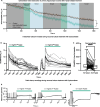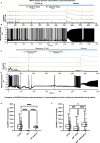Hyaluronidase-induced matrix remodeling contributes to long-term synaptic changes
- PMID: 39897766
- PMCID: PMC11782146
- DOI: 10.3389/fncir.2024.1441280
Hyaluronidase-induced matrix remodeling contributes to long-term synaptic changes
Abstract
Extracellular brain space contains water, dissolved ions, and multiple other signaling molecules. The neural extracellular matrix (ECM) is also a significant component of the extracellular space. The ECM is synthesized by neurons, astrocytes, and other types of cells. Hyaluronan, a hyaluronic acid polymer, is a key component of the ECM. The functions of hyaluronan include barrier functions and signaling. In this article, we investigate physiological processes during the acute phase of enzymatic ECM removal. We found that hyaluronidase, an ECM removal agent, triggers simultaneous membrane depolarization and sharp calcium influx into neurons. Spontaneous action potential firing frequency increased rapidly after ECM destruction in interneurons, but not pyramidal neurons. Hyaluronidase-dependent calcium entry can be blocked by a selective antagonist of N-methyl-D-aspartate (NMDA) receptors, revealing these receptors as the main player in the observed phenomenon. Additionally, we demonstrate increased NMDA-dependent long-term potentiation at CA3-to-CA1 synapses during the acute phase of ECM removal. These findings suggest that hyaluronan is a significant synaptic player.
Keywords: NMDA receptors; extracellular matrix; hippocampus; hyaluronidase; synaptic plasticity.
Copyright © 2025 Sokolov, Krut’, Belousov, Rozov and Mukhina.
Conflict of interest statement
The authors declare that the research was conducted in the absence of any commercial or financial relationships that could be construed as a potential conflict of interest. The author(s) declared that they were an editorial board member of Frontiers, at the time of submission. This had no impact on the peer review process and the final decision.
Figures




Similar articles
-
Extracellular matrix integrity regulates GABAergic plasticity in the hippocampus.Matrix Biol. 2024 Dec;134:184-196. doi: 10.1016/j.matbio.2024.11.001. Epub 2024 Nov 2. Matrix Biol. 2024. PMID: 39491759
-
Plasticity of synaptic GluN receptors is required for the Src-dependent induction of long-term potentiation at CA3-CA1 synapses.Hippocampus. 2011 Oct;21(10):1053-61. doi: 10.1002/hipo.20818. Epub 2010 Jun 2. Hippocampus. 2011. PMID: 20865743
-
Mechanisms of NMDA Receptor- and Voltage-Gated L-Type Calcium Channel-Dependent Hippocampal LTP Critically Rely on Proteolysis That Is Mediated by Distinct Metalloproteinases.J Neurosci. 2017 Feb 1;37(5):1240-1256. doi: 10.1523/JNEUROSCI.2170-16.2016. Epub 2017 Jan 9. J Neurosci. 2017. PMID: 28069922 Free PMC article.
-
Formation and remodeling of the brain extracellular matrix in neural plasticity: Roles of chondroitin sulfate and hyaluronan.Biochim Biophys Acta Gen Subj. 2017 Oct;1861(10):2420-2434. doi: 10.1016/j.bbagen.2017.06.010. Epub 2017 Jun 15. Biochim Biophys Acta Gen Subj. 2017. PMID: 28625420 Review.
-
The brain's extracellular matrix and its role in synaptic plasticity.Adv Exp Med Biol. 2012;970:153-71. doi: 10.1007/978-3-7091-0932-8_7. Adv Exp Med Biol. 2012. PMID: 22351055 Review.
Cited by
-
Phospholipid-Drug Conjugates in Cancer Therapy: Emerging Paradigms and Future Directions.AAPS PharmSciTech. 2025 Jul 14;26(6):190. doi: 10.1208/s12249-025-03175-8. AAPS PharmSciTech. 2025. PMID: 40659903 Review.
References
-
- Arranz A. M., Perkins K. L., Irie F., Lewis D. P., Hrabe J., Xiao F., et al. . (2014). Hyaluronan deficiency due to Has3 knock-out causes altered neuronal activity and seizures via reduction in brain extracellular space. J. Neurosci. 34, 6164–6176. doi: 10.1523/JNEUROSCI.3458-13.2014, PMID: - DOI - PMC - PubMed
-
- Brakebusch C., Seidenbecher C. I., Asztely F., Rauch U., Matthies H., Meyer H., et al. . (2002). Brevican-deficient mice display impaired hippocampal CA1 long-term potentiation but show no obvious deficits in learning and memory. Mol. Cell. Biol. 22, 7417–7427. doi: 10.1128/MCB.22.21.7417-7427.2002, PMID: - DOI - PMC - PubMed
MeSH terms
Substances
LinkOut - more resources
Full Text Sources
Miscellaneous

